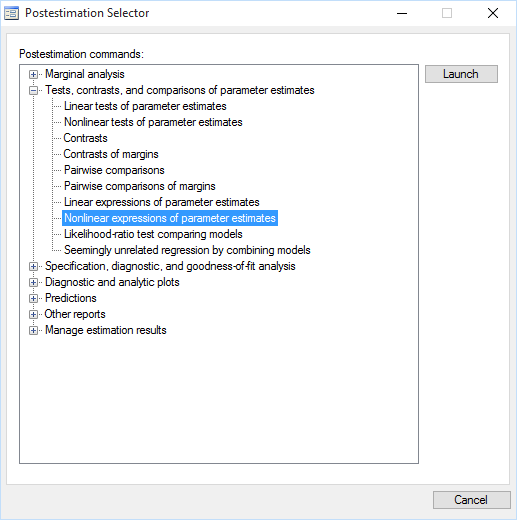In the spotlight: What's next
Stata promotes an estimation/postestimation paradigm. Which is to say, first you estimate something and then you analyze those estimates. After a linear regression, you might test whether two parameters are the same, or predict leverage statistics, or test for heteroskedasticity, or look at diagnostics plots, or do any of about 70 other things. Actually, the number of things you might do numbers in the thousands, but they fall under 70 or so commands or facilities.

First, wow! That’s a lot of different things I could do. How did I know about all that? Well, it is fully documented in [R] regress postestimation. But what if I had requested robust standard errors? We then lose the postestimation facilities that are based on the likelihood, because the likelihood no longer has the same interpretation. How did I know that? Again, it is documented, but you have to look closely at the documentation.
What if, instead of linear regression, I had run a logistic regression? We now have about 60 general things we can do to further analyze that regression. Some of those things are the same as the ones after linear regression, while others are new and specific to logistic regression. Again, all documented in [R] logistic postestimation. You can see that it becomes tricky to keep up with what is available.
So, what’s next?!
Or, more accurately, what’s available to do next?
If you want to know, launch the Postestimation Selector—a boring name for a nifty tool. Just click on Postestimation Selector in the Statistics menu. It will show you exactly what is available for whatever you have most recently estimated or most recently restored from previously saved estimations. Want to see a “Nonlinear expression of parameter estimates” with confidence intervals and a test against zero? Click on it, and type or build your expression.
Whenever you estimate a new model, the Selector updates itself. You can drag it to an unused corner of your desktop and just leave it up as you work.
A written description of the Selector simply cannot do it justice. Luckily, my colleague Chuck Huber has created a video. Take a look.
—Vince Wiggins
Vice President,
Scientific Development







